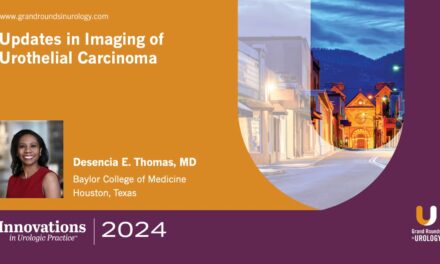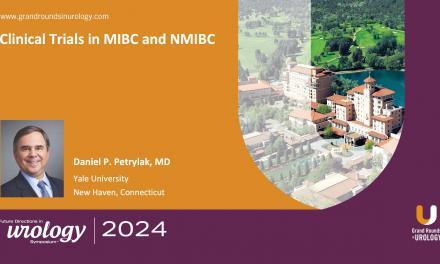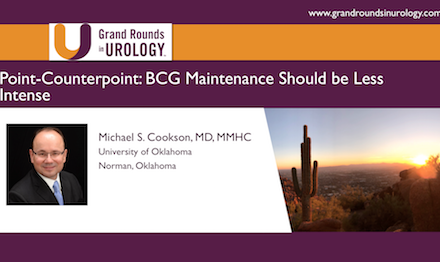Dr. Michael S. Cookson presented “Difficult Issues in Non Muscle Invasive Bladder Cancer” at the 26th Annual Perspectives in Urology: Point-Counterpoint, November 10, 2017 in Scottsdale, AZ
How to cite: Cookson, Michael S. “Difficult Issues in Non Muscle Invasive Bladder Cancer” November 10, 2017. Accessed Jun 2025. https://grandroundsinurology.com/difficult-issues-non-muscle-invasive-bladder-cancer/
Summary:
Dr. Michael S. Cookson, MD, MMHC, provides an update on risk stratification and discusses the importance of identifying BCG-failed patients early so they can move on to additional therapy.
Difficult Issues in Non Muscle Invasive Bladder Cancer
Transcript:
Just by show of hands, how many of you use Cysview blue light in your practice? Wow, I see no hands. You might want your hospital to know that the FDA has now just cleared the hurdle of reimbursement, enhanced reimbursement for the use of it, and that will probably allow your hospital to buy the or lease the equipment that is necessary to do it. But that has been usually the biggest barrier, so if you are not using it, you might.
All right. So we’re going to move on, and we’ll talk about those enhanced imaging as they have made their way into the guidelines too. Did you want to do an ARS question on this first? All right, so first ARS question, we didn’t do the last one, but I think they learned the BCG unresponsive answer along the way. Based on the AUA SUO 2017 guidelines for non-muscle invasive disease, a repeat TUR would be indicated for and your choices are T1 tumor, variant histology, high-grade TA, or all of the above?
It looks like 75% picked all of the above, and we will discuss that. And I believe there is a second ARS question for this group. Based on the AUA SUO guidelines, BCG maintenance therapy is recommended for three years in patients with CIS, Ta, T1 low-grade, nested variant? Those are your choices.
All right. It looks like 73% picked CIS. Still a fair number picked high-grade Ta so we’ll talk about that in the risk stratification part. If we could go back to the slides then, I always bring you a little bit from Oklahoma. So this is Will Rogers, “Good judgment comes from experience, and a lot of that comes from bad judgment.” I’ve certainly been guilty of that along the way.
So the AUA guidelines for non-muscle invasive bladder cancer came out about a year ago. They highlighted the things that we just introduced, risk of recurrence, and risk of progression. Looking at the risk stratification to try and really help identify the right way to go with the treatment, so it isn’t just a naming or a diagnostic tool, but it actually is a way to stratify the treatment regimen that we do.
They start out pretty easy, but you would think that this stuff would be that easy to get, but I can tell you we review a lot of operative reports and notes from across different practices, and sometimes just basic things like the size of the tumor, location, whether it was multiple or not, papillary or sessile, other abnormal mucosal, did you perforate the bladder or did you think you didn’t, those are just basic things that are not in a standardized op note, but it would be nice if they were, so they do include some guidance on that, and then, you know, the goal unless the tumor is so big that you can’t completely resect it or the patient needs to be awakened because they are not tolerating the procedure, the goal should be completely tumor resection when feasible. The studies that have been done on these enhanced technologies kind of—they reveal to us that we are really not able to completely resect all tumors all the time even though our eyes may tell us that we’re doing a pretty good job.
At the time of original presentation, the patient should undergo upper tract imaging, and that imaging is usually either retrogrades and an ultrasound or CT urogram. It is something that lights up the lining of the urothelium as well at the time of initial presentation. It’s surprising how few patients have that these days.
In a patient with a history of non-muscle invasive disease who has like a positive urinary cytology but the bladder itself looks okay, they remind us to look for extravesical sites, upper tract as I mentioned, prostatic urethra, and enhanced detection techniques may be valuable there too.
So, at each time of occurrence or recurrence, the clinician should assign a staging and a risk strata low, intermediate or high-risk for those patients. Before this guideline came out, most of what was out there for risk stratification was derived from some European and Spanish studies, many of those patients that had BCG too. So those are out there. There’s little tools even an EORTC risk calculator so they include the usual suspects, size, grade, stage, recurrence, pattern, and number. The AUA took it one step further. They added some additional risk strata, so lymphovascular invasion, prostatic urethral involvement, variant histology, and if they’d had a poor response to previous BCG.
So this is the risk stratification table that they use. There are not that many low-risk patients, right? They are very—those are the small, low-grade solitary TA tumors, and then the pun lumps, the very low malignant potential neoplasia. The high-risk ones are high-grade T1, because there aren’t very many low-grade T1s, recurrent high-grade TAs, large high-grade TAs, any CIS, BCG failed patients, variant histology, lymphovascular invasion, and prostatic urethral involvement, and we’ll talk about the recommendations for the treatment based on the sorting of those into those into those categories, they highlighted the importance of recognizing variant histology, so all of us use different pathologists. Some are really good and have expertise. Some of them may not, so if you get a variant histology, if you start hearing the words like plasma cytoid, nested variant, micropapillary, those are buzz words that you would want to get a better opinion on it if you are not comfortable with it because many times that would change the therapy simply based on getting that right at the start.
If you are considering any kind of bladder sparing, and you have a variant histology, you better go back and re-resect those patients, and there are just too many patients that are already muscle invasive, for example, in those nested variants, etc. They did discuss urinary markers, but they state clearly that they have not replaced cystoscopy for evaluation as we sit here today. So they listed the markers, they say it’s hard to compare them directly because of the way the studies are done, but we can’t just omit office cystoscopy as the follow-up based on urinary markers.
Where they did see value in those markers was in patients that are sort of needing an arbitrator so if you are having an atypical cytology and you are not sure what that means, if you have had assessing response to, for example, BCG therapy with the FISH as I outlined in my first talk, there is value there. For low-risk patients, at least based on the markers that they evaluated at the time, they didn’t feel like any of them were really performing well enough to use them for routine, more for the higher-risk patients.
The value of a repeat TUR, so this was mentioned in the pre-question, patients that you can’t completely resect, they need to go back and re-resect them. The medicine is not going to make the tumors disappear in most cases. For high-grade Ta tumors, it was strongly recommended to go back, and for T1 tumors, unless you are going to remove their bladders based on that, you need to go back. So those were all part of it, this is one study that was done a few years ago looking at T1 tumors and the value of that re-resection in the patients who underwent a repeat resection had lower rates of recurrence, and also had less progression of their disease, so it can be both diagnostic to uncover a more invasive tumor in the T1, and it also can be a value for figuring out who is now completely resected so they can go on to benefit from the therapy.
So these are listed here. I think we had a multiple choice, but incompletely resected high-grade TA, T1, and variant histologies are all very reasonable for that 4 to 6 weeks. Go back and repeat the resection.
They included a section on single-shot intravesical therapy. That’s for the low-grade or the intermediate risk patients. These are not people that you are predictably—you know they are going to need BCG, you know they are going to need some sort of induction chemotherapy, but for those little tiny tumors when there is no perforation certainly there has been some level one evidence to suggest that a single installation of Mitomycin can reduce the risk of recurrence over the next 12 to 24 months.
For induction therapy for the truly low-risk patients, that small TA tumor or the low malignant potential tumor, they don’t need intravesical therapy, they simply need to be followed. For patients that are intermediate risk though, those patients can either have chemotherapy six weeks or BCG for six weeks, and then for those high-risk patients, which we went over in the menu, those patients should undergo BCG therapy for six weeks based on the superiority over intravesical chemo.
And then when you’re an intermediate risk patient and you have responded to that first six-week course, then you can consider maintenance if it was chemotherapy, maintenance chemo. If it was BCG, maintenance BCG, but they cut off the BCG at one year for the intermediate risk group based on trials that we’ll show a little bit later, and for the high risk patients they are recommended to do longer duration of maintenance, and some data suggests up to three years may be of benefit.
What about the BCG failed patients? Well, we just talked about that so I don’t think we really have to duplicate our efforts here, but they do include management of BCG unresponsive and salvage treatments for these patients, so if you are failing after a single six-week course, you can go on especially for the Ta tumors to get maintenance or a second six-week course if you have a T1 tumor though and you have another T1 right after that six week it’s kind of a special circumstance, and you certainly have the benefit of knowing that there’s data to remove bladders in that setting and radical cystectomy should be discussed with the patient before you proceed with your next step, and then this talks about those patients that meet the definition of failure so if you’ve had two six-week courses or six weeks in maintenance and you are still recurring, then you’re by definition unresponsive, and you may be offered a switch to cystectomy or clinical trial as my first talk outlined. They also bring up the cystectomy. If you remember when we first started talking, I said up to a third of patients with high-risk non-muscle invasive disease will undergo a cystectomy so it is permeated throughout the guidelines that those patients may need that. It’s not recommended for those low-grade, low-stage ones, but it is recommended for the high-grade, recurrent, and T1 tumors, and certainly those mixed variant histologies that we talked about.
Enhanced cystoscopy made it to the guidelines so that was the first time, and it includes both the Cysview and the blue light. It includes the narrow band imaging. Notice the strength of evidence as I told you is better for the enhanced Cysview and the photodynamics as opposed to the narrow band, but both are mentioned as ways in there to both improve on the enhanced detection and decrease recurrence.
So we already talked a little bit about the narrow band. It takes advantage of the wavelengths in which blood vessels absorb light looking at the blue-green spectrum, and the easiest way I think is to think about, you know, being in the ocean and the background is green and the tumors are the little brown people floating on top. And that’s exactly how it works, and that’s how it looks.
The data I showed you earlier has benefitted from an enhanced detection, which has then resulted at least in some series in a reduction in recurrences because you did a better job the first time around.
The blue light we also talked about in my first talk so we’ll just say that they’re in the guidelines. The enhanced detection is available through the FDA. There is also on the move right before the FDA currently flexible blue light in the office, so that was a clinical trial that was presented at the AUA last year, and is now moving forward, but this is currently operative room type recommendation. It does require a special Karl Storz proprietary set up and then the medicine has to be placed in the bladder usually 45 minutes to an hour before the TUR, and then the protoporphyrin is selectively up taken ten times greater than normal tissue so it allows you in many cases to see better. This is just some different trials that I will highlight that show that it was enhanced detection of the Ta as well as the T1 tumors, which then resulted in a reduced recurrence, and that has been shown in the U.S. pivotal trial that’s shown here. So it’s about a 20, 16-20%, it depends on which type of tumor you’re looking at, and which study you look at. The guidelines also presented data on follow-up, which we all are aware of, but it was noted that we probably are overdoing it with the low-risk patients. So for low-risk patients those little TA tumors usually look at somewhere in that three-month range. If it’s negative you probably don’t need one for nine months after that so basically could get by with two cystoscopies for the year. That’s different than the patients that have the higher-grade tumor. They also acknowledge that office fulguration is a reasonable option for these low-grade, low-stage tumors. Not everybody needs to go to the operating room, and then for them they really don’t require a lot of visual and upper tract for the truly low-grade, low-stage ones. That’s different than intermediate and high-risk. They do recommend every year or two some sort of upper tract imaging, so that should be probably part of your algorithm as well as every three-month cystoscopies at least for the first two years and then six months in the three, four, five years until you get out, about five years where they still need at least annual cystoscopies, so I think that is the end of the non-muscle invasive guidelines.
So the take-home points there we talked about, risk stratification, value of taking back and doing a doing a repeat TUR for those special circumstances listed. Judicious use of technology where it’s available to you, maintenance therapy with the intermediate for one year and three years for the higher-risk patients, and identification of BCG-failed patients early so you can move on to additional therapy, clinical trials or cystectomy. So with that I thank you
ABOUT THE AUTHOR
Michael S. Cookson, MD, MMHC, is Professor and Chairman of the Department of Urology and holds the Donald D. Albers Endowed Chair in Urology at the University of Oklahoma Health Sciences Center in Oklahoma City. He has authored some 240 peer-reviewed journal publications as well as more than 30 chapters of various textbooks, and he is nationally recognized for his outstanding contributions to urologic oncology. Dr. Cookson completed his Urology Residency at the University of Texas, San Antonio, and completed his Urologic Oncology Fellowship at Memorial Sloan-Kettering Cancer Center in New York. From 1998 to 2013, he served as the Vice Chairman of Urologic Surgery and Director of the Urologic Oncology Fellowship Program at Vanderbilt University. Dr. Cookson has devoted much of his academic career to the management of patients with urologic cancers, with a strong emphasis on clinical guidelines, education, and evidenced-based medicine. He was a member of the AUA/ABU Examination Committee for 10 years, serving as Oncology Consultant and Pathology Editor. He also serves on the ABU Oral Examination Committee. He is a Co-Founder of the Oncology Knowledge Assessment Test (OKAT), an SUO-mandated examination. He also served as Chair for the OKAT for 5 years. In 2011, he received the President’s Distinguished Service Award from the SUO for educational contributions. He received the 2018 AUA Presidential Citation for Outstanding Service for his role in the development of the OKAT and as Chair of the Castration-Resistant Prostate Cancer Guidelines Committee at the AUA 2018 Annual Meeting. Dr. Cookson has previously served as a member of the AUA Guidelines on Localized Prostate Cancer Committee. Dr. Cookson is currently serving out the 2019-2020 term as the SUO President.




